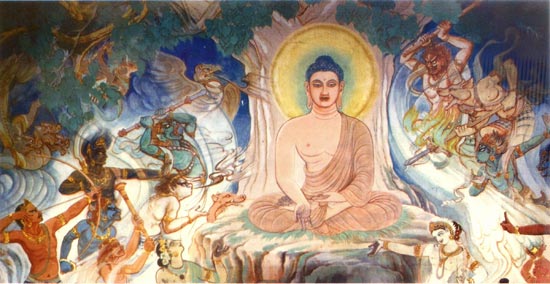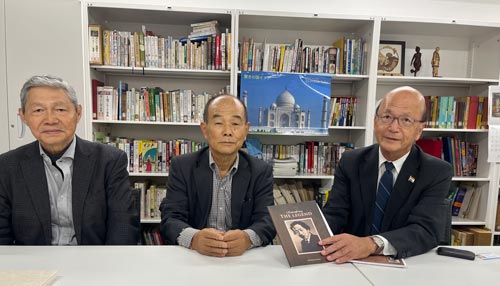A marvel of murals and cooperation

Kosetsu's hybrid Indo-Japanese murals once again in their full splendour: Mara and his army attack Bodhisatta and top right, Offering kheer by Sujatha to Bodhisatta
Near century-old murals in the main hall of the iconic Mulaghandakuti Vihara built by Anagarika Dharmapala in holy Isipathana (Sarnath, Varanasi) have come to life once again. The vihare is where the most revered sacred relics of the Buddha, discovered by British archaeologists near Taxila in colonial India in 1913-14 and handed over for safe custody to the Maha Bodhi Society of India, are enshrined.
With the withered paint peeling off the murals due to inevitable decay caused by the passage of years, it was a team of experts from Japan who have come to the rescue and restored the frescoes to their original magnificence.

Restoration work in progress at the Mulaghandakuti Vihara
Anagarika Dharmapala built the temple at Sarnath at the turn of the 20th century, for Buddhists of the world to venerate the site at which the Buddha enunciated the Doctrine of the Middle Path for the first time. That message was taken throughout Central Asia – to Persia (present-day Iran) and the Far East – to Japan by merchants, explorers and pilgrims alike.
Dharmapala had envisioned murals depicting chronicles of the life of the Buddha on the walls of the newly- built temple. Having visited Japan several times he had been greatly impressed by their ancient artistic and cultural life. As a founder member of the Japan India Association (JIA) which exists to this day, he asked for help to find an artist who would do justice to the temple he had built. JIA turned to the Imperial Japanese Government for assistance.
Fresco artist Kosetsu Nosu, the son of a Mahayana Buddhist monk who had studied the famous cave paintings at Ajanta was the ideal candidate for the task. Familiar with the fusion of Indian and Japanese art, he was recruited and spent five years in India completing the murals.
Dharmapala himself was able to see only a single sketch of Kosetsu’s drawings – ‘Conquering the devils and Enlightenment’. Pleased with what he saw, he gave Kosetsu the green light for the project. Dharmapla passed away four months later in 1933 in Sarnath unable to see the finished product of the murals – 44 metres in length and 4.4 metres in height.
With Dharmapala’s passing, Kosetsu funded the project himself by holding exhibitions of his own paintings. JIA and the Imperial Japanese Government chipped in later.
The people of Varanasi recorded their appreciation of the artist’s murals completed in 1936 in a letter they sent Kosetsu. He received a “roar of applause” at the Tokyo station on his return to Japan, according to Yutaka Miyahara of the present-day ‘Society of honouring the Master Artist Nosu Kosetsu’.

Behind the restoration: (L-r) Yutaka Miyahara, Prof Shigeki Mizobuchi and Nishimoto Tatsuo holding up an image of legendary artist Kosetsu
The restoration work of recent times was began just before the COVID pandemic struck. Venerable Pelawatte Seewalee Thera, General Secretary of the Maha Bodhi Society of India, the custodians of the Mulaghandakuti Vihara made contact with JIA who together with the Indian embassy in Tokyo tracked down Kosetsu’s descendants in his birthplace of the Kagawa Prefecture. They turned to Professor Takayasu Kijima and Curator Professor Shigeki Mizobuchi.
When word went around that the Maha Bodhi Society was seeking help – and funds, as the Indian Government at home had blocked it from accepting foreign currency under its Foreign Currency Regulations Act (FCRA), the Buddhists of Kagawa Prefecture freely donated money for the restoration project.
Restoration work began in earnest shortly thereafter, and the first phase was concluded at end 2019, when the worldwide pandemic disrupted the work. Last year, the project resumed and was successfully completed by a team led by Prof. Mizobuchi.
Today, as pilgrims from all over the Buddhist world resume visiting holy Sarnath post-pandemic, and attend the reciting of the Dhammachakka Sutra (unfailingly performed every evening at the Mulaghandakuti Vihara through world wars, monsoons and pandemics), they will be able to see the marvel of Kosetsu’s hybrid Indo-Japanese murals once again in their full splendour.
This is also a story of Indo-Japanese cooperation spreading over a century, the devotion of a legendary Japanese artist, commitment by his family and his students, the spontaneous philanthrophy of the humble people of Kagawa Prefecture, and the backing of the Governments of India and Japan to support the temple built by a Sri Lankan in India.
Searching for an ideal partner? Find your soul mate on Hitad.lk, Sri Lanka's favourite marriage proposals page. With Hitad.lk matrimonial advertisements you have access to thousands of ads from potential suitors who are looking for someone just like you.


